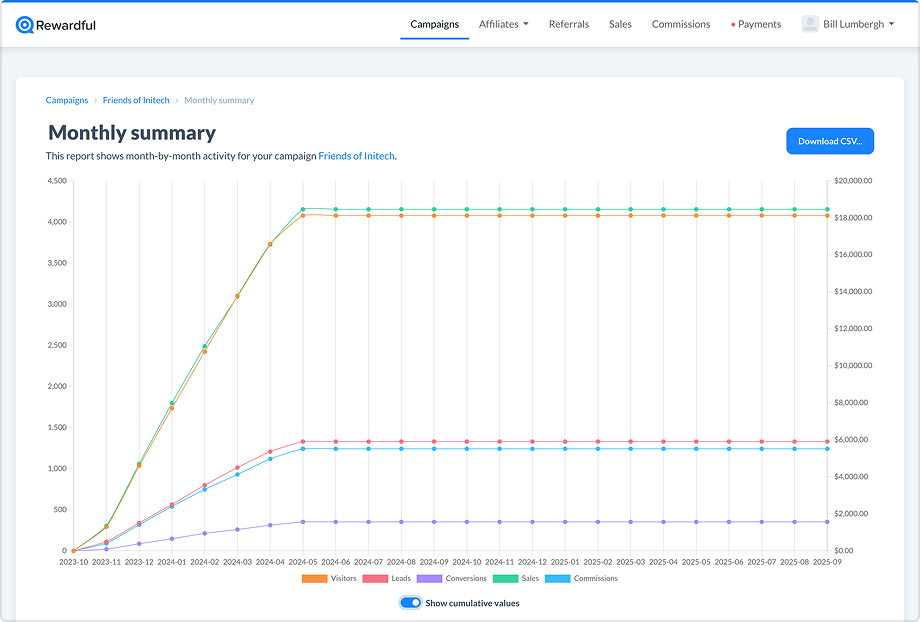I’ve seen hundreds of affiliate programs launch with promise, but half fail after six months. Why do many affiliate programs struggle to last? What affiliate management mistakes cause them to falter?
From the many affiliate programs across SaaS, fintech, and creator-led businesses that grow and then fall apart, I’ve identified a clear pattern: affiliate programs don’t fail because affiliate marketing doesn’t work, but they fail because the systems behind them do.
In this blog, I’ll break down the most common reasons many affiliate marketing programs fail after a few months, and share what the successful ones do differently to build sustainable, long-term partnerships.
1. They Treat Affiliates Like an Audience, Not Partners
Most companies start with the wrong assumption that an affiliate program is just a promotional channel. “Recruit the affiliates, give them links, pay commission.” Sounds easy, right?
It works… for a few weeks. Then, affiliate partner engagement drops.
Affiliates stop promoting because they feel disconnected. They don’t get product updates, company context, or visibility into their referrals. It’s like asking someone to sell blindfolded.
The instinctive “fix”—raising commissions—is often a costly distraction. Instead, the affiliate programs that succeed focus on providing effective communication. Sharing product updates, audience insights, and promotional assets turns affiliates into extensions of your marketing team.
From the affiliate programs powered by Rewardful, I’ve seen the best programs treat affiliates as creative partners, not just traffic sources. They don’t just hand over links and promo codes—they give affiliates the stories, context, and tools they need to authentically promote your brand.
2. They Confuse Referral Programs with Affiliate Programs
One of the most common affiliate manager mistakes I see is treating affiliate programs like referral programs.
Referral programs are, generally, one-to-one, while affiliate programs are one-to-many. They scale differently, and their motivation is different. Yet, many founders design affiliate commission structures meant for referrals (small one-time bonuses) and then wonder why affiliates disappear after a month.
Affiliate incentives need to match effort. A 10% cut might be fine for casual promoters, but serious creators and marketers need recurring commissions and transparent attribution.
The commission strategy is crucial:
- Recurring commissions align incentives.
- Transparent affiliate attribution builds trust.
- Automated tracking removes disputes.
Without this foundation, your affiliate program is just partner enthusiasm on borrowed time.
What’s the typical affiliate commission rate for SaaS programs? We analyzed over 250 programs managed with Rewardful and found the standard rate falls between 20% and 30%. See the full data breakdown here.
3. They Onboard Affiliates, and Then Disappear
I often see affiliate managers pour all their energy into recruiting partners, but almost none into onboarding them.
You’d never hire a new salesperson, hand them a product link, and call it a day. Yet that’s exactly how many programs treat affiliates—even their best ones. It’s a setup for affiliate program failure.
Across the hundreds of affiliate programs running on Rewardful, the first 30 days after signup decide everything. That’s when someone either becomes a brand advocate or fades into your dashboard stats.
Sustainable affiliate programs tend to guide new partners through:
- A clear setup flow (personal link, coupon, and dashboard).
- A first-sale milestone (a simple goal with an incentive).
- A communication touchpoint (a quick check-in email or short call).
If you want longevity, optimize for speed to first success, not speed to signup. A smaller group of active, confident affiliates will always outperform a large group of confused ones.
Need some guidance on how to onboard and activate affiliates? These affiliate onboarding best practices can help.
4. They Don’t Know Which Affiliates Are Driving Results
Here’s a test: if you can’t name your top three affiliates without checking a report, your program isn’t as healthy as you think.
This is where many affiliate programs stall. The problem isn’t just tracking but also the entire reporting flow. When data lives in spreadsheets (a recipe for affiliate management failure), reports lag behind, and commissions are paid without context, it becomes impossible to see what’s really driving sales.
What looks like a “performance problem” is actually a visibility problem. Without a clear view of what’s happening, teams lose trust in their data, and affiliates lose trust in the program.
You can’t improve what you can’t see:
- You don’t know which affiliates deserve more attention.
- You don’t know which offers are actually converting.
- You don’t know who’s quietly losing interest.
In my experience working with hundreds of SaaS affiliate programs, this lack of clarity kills momentum fast. By month six, leadership writes the affiliate marketing channel off as “inefficient.” The truth? It wasn’t underperforming, but under-tracked.
The most resilient affiliate programs use automation to bring transparency, not just speed. Real-time dashboards, accurate affiliate sales attribution, and clean integrations turn data into insight—and insight into trust between teams and partners.
5. They Ignore the Product–Marketing Connection
How often do you share product updates with your affiliates? Many affiliate managers don’t keep partners in the loop on feature launches, pricing changes, or other developments that highlight the product’s value.
If the product message shifts and affiliates aren’t updated, you create a mismatch: the wrong traffic, the wrong leads, the wrong expectations. The affiliate channel starts attracting people who cancel early, and your metrics make it look like affiliates bring “low-quality” customers.
I’ve seen this pattern in SaaS all the time. Product teams evolve, pricing changes, but affiliates are still promoting the same old story.
Sustainable programs close that gap by looping affiliates into product updates the same way they loop in sales or support teams. The more affiliates understand why customers buy, the better they can sell to them.
6. They Measure Affiliate Activity Instead of Alignment
After six months, many affiliate managers start evaluating affiliate programs using surface-level metrics: signups, clicks, or posts. These numbers feel good, but they don’t reveal whether the program is actually driving meaningful results.
The affiliate programs that thrive focus on alignment, not activity. They ask questions like:
- Do our affiliates reach our ideal customers?
- Does their content attract the right kind of traffic?
- Are we nurturing quality relationships, or just chasing volume?
Programs that prioritize audience alignment may grow slower at first, but their networks are far stronger in the long run. Partners stay because there’s a true fit with the brand, not because of a quick incentive.
Not sure what metrics you need to track? This affiliate marketing metrics guide can help.
7. They Never Make Affiliate Management Anyone’s Actual Job
Leaving the program as a side project is one of the most damaging affiliate manager mistakes I see. The early stage often looks like this: a marketing manager juggling paid ads, content, and affiliate emails. Inevitably, things slip. Reporting is delayed, communication dries up, and partners feel neglected.
You don’t need a full team, but you do need clear ownership. Even 5–10 hours a week from one responsible person—someone to send updates, review data, and keep payouts clean—can make the difference between a living program and a forgotten one.
When nobody owns it, affiliates notice. They need a go-to person who actually has time for them. If they don’t, they’ll move on to other partnership programs where they’re valued, or at least not ignored.
8. They Automate the Wrong Things in Their Affiliate Program
Automation isn’t the enemy, but bad automation is.
I’ve observed that many affiliate programs automate everything except the parts that build strong relationships. Affiliate communication is replaced with cold email templates that lack personalization, affiliate onboarding is reduced to sending PDFs, and meaningful interactions between the company and affiliates are swapped for newsletters that nobody reads.
The result? An affiliate program that looks efficient on paper but feels impersonal to the people driving your growth. Affiliates start ignoring emails, disengaging from campaigns, and eventually dropping out entirely.
The solution is a careful balancing act:
- Automate the transactional work: data analysis, attribution tracking, and payout management. This removes errors and frees time.
- Invest human energy where it counts: affiliate onboarding, feedback, strategic check-ins, and relationship-building. This is what creates loyal, motivated partners.
Affiliate programs that strike this balance scale and sustain growth because their affiliates feel valued, informed, and part of the team.
What All Surviving and Thriving Affiliate Programs Have in Common
After six months, the affiliate programs that survive and thrive look very different from those that fizzle out. They’re steadier, far more structured, and often smaller. These are the recipes for long-term partner success and sustainable growth.
Here’s what sustainable affiliate programs consistently do:
At their core, sustainable affiliate programs build trust at scale. Every system—onboarding, payout, and communication—is a signal of reliability. Most programs don’t fail because the concept is broken, but because they weren’t designed to last.
Fast partner recruitment, quick payouts, and minimal tracking can deliver early wins. But affiliate retention strategies and long-term growth come from consistency, transparency, and alignment.
From what I observe across programs running on Rewardful, the six-month mark is a tipping point: programs either stabilize or disappear. And most importantly, affiliate program success rarely depends on budget; it comes from structure, ownership, and respecting your partners.
Build An Affiliate Program That Lasts With Rewardful
If you’re launching or rebooting an affiliate program, design it like you plan to keep it. Affiliates quickly notice the difference between a campaign that’s temporary and one that’s built for the long term.
Affiliate software that integrates with Stripe, like Rewardful, can help you put these principles into practice. It automates what needs efficiency while keeping the human touch where it matters, so your affiliate program not only launches successfully, but grows sustainably.















